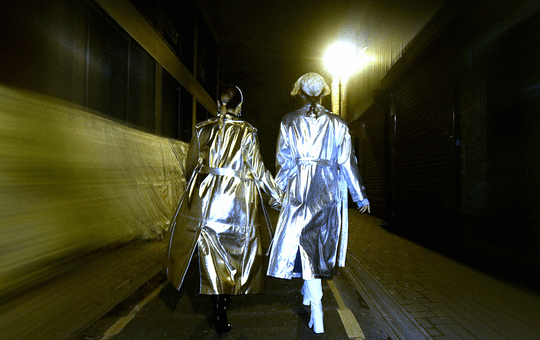Emptyset interview: "The house posed obscure questions."
Bristol’s foremost operatives in experimental electronics, Emptyset, put out their third album earlier this year. Released on the Multiverse label Subtext, ‘Medium’ is particularly important for two reasons. The first being the album’s rather spectacular excursions into Emptyset’s rigorously wrought and exquisitely textured avant-techno. Secondly, there’s the album’s unusual and rather fascinating recording process.
Emptyset’s James Ginzberg and Paul Purgas made ‘Medium’ in an isolated Victorian Gothic mansion that was mysteriously abandoned, half-finished, in 1873. They built the space itself into the recording process, creating an album which was as much a product of the building’s brooding atmospherics and unsettling presence as it was of them and their hardware. The final result is mesmerising. ‘Medium’ is an incredible, hulking juggernaut of an album, one whose power is sensed rather than seen. Sounds are coerced into showing themselves against a truly dark, oppressive silence. Each beat uncurls sinuously, humming with menacing, latent electricity, before retreating, leaving the listener in the pitch-black silence – until the next barrage of sound again illuminates a small patch of the ominous terrain ahead. Paul Purgas from the band answered a few questions about the recording of this rather singular album.
Would it be fair to say you’ve a long standing interest in architectural spaces?
Yes that would make sense, through James’ background studying literature and researching fictional representations of space and my own in architecture and design. Collectively we have always been open to investigating processes that would enable the real and spatial to feedback into the constructed world of the project. Through Emptyset even from our very early productions there was an interest in how we could integrate space and live recording techniques as a means of adding texture and depth to the material. What were initially executed as quite crude experiments as we developed into ‘Demiurge’ (their second album) became more elaborate signal chains with live mic setups within the studio, employing feedback as a more active force for both ornamentation and eventually shaping the compositions themselves. With ‘Medium’ there came an opportunity to look at more centrally locating architecture within this production model and exploring a more instrumental and direct means of translating space into sound. Previously our approach had been focused around working in isolation in a studio with hardware so it felt like here was an opportunity for us to take this model into an active environment that could in some ways becomes both a character and contributor within the narrative and processes of making a record.
How did you come across Woodchester Mansion? What drew you to it?
We’d heard about it from a friend who had mentioned an unfinished mansion in Gloucestershire that had staircases leading nowhere and mantel pieces floating in space. Then one day whilst working on the initial ideas for ‘Demiurge’, over two years ago now, we visited Woodchester as a break and it instantly captured our imaginations. Many of the details of the house didn’t add up or appeal to easy resolution. On a literal level the structure itself was formally an embodiment of an incomplete dream, a masterplan frozen in time. Though in addition the location of the house posed obscure questions, as it had been positioned very deliberately within a valley in a secluded area that delivered very little direct sun light and restricted the movement air. Equally the functions of the building seemed multi-layered with Woodchester Mansion operating as a base for stone masons, psychic researchers and also as a sanctuary for bats. It was collectively all of these details contained within the overarching edifice of the mansion that created a strong enough motivation for us to develop ‘Medium’ over the last two years.
How did you go about recording in there – did you set up in several different spaces or identify one area and use that?
After visiting the house and recording tests in the various rooms we eventually decided to settle in a central recording space in what was previously the main kitchen of the house, which enabled us to use the adjacent ancillary kitchen as a control room to setup equipment. Acoustically the area had the properties we were looking for and on a practical level enabled us to construct something resembling a studio. We worked with the Bristol based sound engineer Matt Sampson who James has been working with recently on another musical project. He supplied us with a monophonic sound system and an array of vintage mics and preamps. Matt has worked over many years from his own studio not far from ours with live bands and building his own custom made electronics so his expertise was a vital part in bringing Medium to life. In the end we setup multiple mics around various parts of the space from the open areas to obscure crevices in a bid to capture as complete an impression as possible.
Did you edit and rework the pieces after recording them?
Yes this became the most labour intensive part of the record. Essentially we’d recorded a a series of skeletal compositions within Woodchester, so this final stage became about how we could reconstruct these pieces into a coherent whole.
At some places in the album, you can hear really incredible echoes and literally the sound of the room that you are in, how did you make that happen?
From the adjacent control booth we setup a feedback chain with the mic array and then improvised live sections using noise and sine wave pulses channelled into the room. Essentially this operated as a means of translating the space as directly as possible into sound and created the vivid textures and details contained within the record. It’s a process akin to impulse testing and equally mirrored the sonar techniques used by the bats that live within Woodchester.
Subtext released Emptyset’s album ‘Medium’ on 14th March 2012













